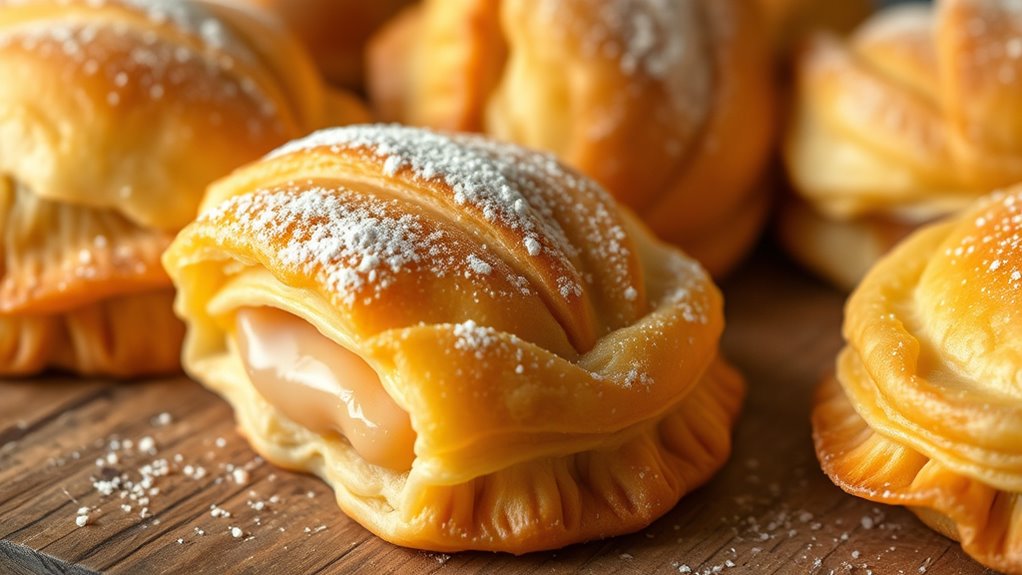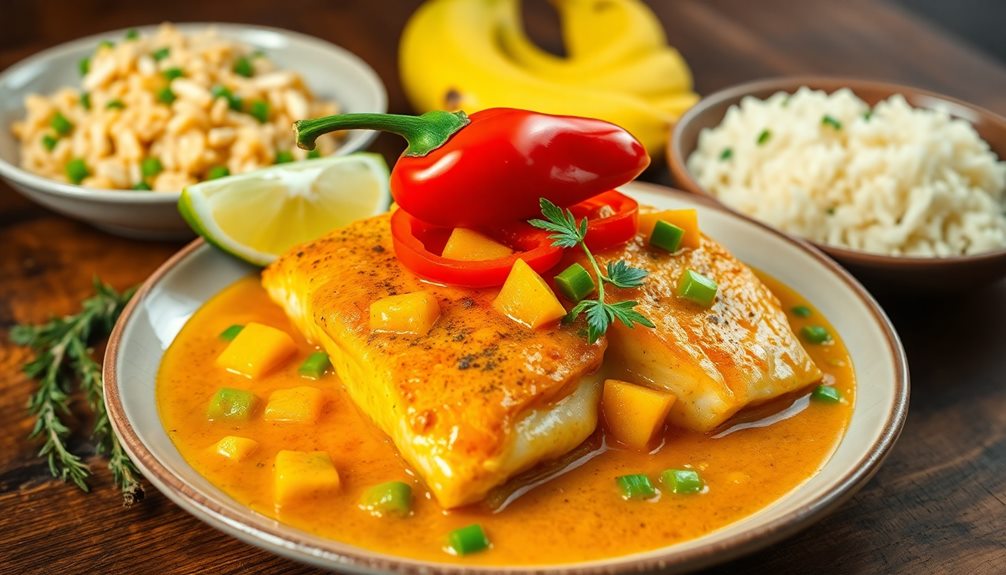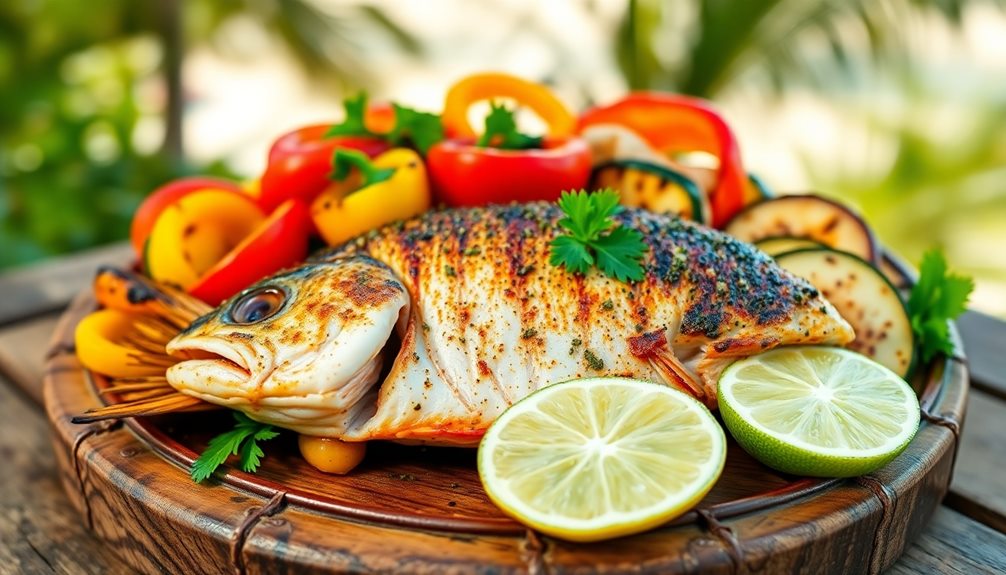The secret behind flaky Cuban pastelitos lies in mastering lamination, where you fold and roll chilled dough to create delicate layers, and handling it gently to prevent toughening. Using butter, sometimes with a touch of vinegar, helps achieve that crisp, tender texture. Proper oven temperature ensures a golden, flaky crust. Pay attention to egg wash for shine and crispiness. Keep experimenting, and you’ll uncover even more tips for perfecting these irresistible pastries.
Key Takeaways
- Proper lamination and folding create multiple flaky, layered layers in the pastry.
- Keeping the dough cold prevents butter melting, ensuring a crisp, tender crust.
- Applying an egg wash before baking enhances shine and crispness.
- Baking at high temperatures (375°F–400°F) ensures a golden, flaky exterior.
- Gentle handling and precise rolling maintain dough integrity and layered structure.

Have you ever wondered what makes Cuban pastelitos so irresistibly delicious? The secret lies in a combination of expert baking techniques and thoughtful ingredient variations that come together to create that perfect flaky, tender crust. When you bite into a pastelito, what you’re really experiencing is a delicate balance—crisp on the outside, soft and flavorful on the inside—and that’s no accident. It’s achieved through precise baking techniques that involve careful handling of the dough, as well as creative ingredient variations that add depth and complexity to the flavor.
First, mastering the baking techniques is essential. The key is in how you handle the dough. Cuban pastelitos are typically made from a laminated pastry dough, similar to puff pastry, which requires folding and rolling to create multiple layers. You’ll want to keep the dough chilled throughout the process to prevent the butter from melting, ensuring those layers puff up during baking. When rolling out the dough, use light, even pressure, and avoid overworking it, which can toughen the pastry. Once assembled, baking at a high temperature—usually around 375°F to 400°F—helps achieve that golden, flaky exterior. Brushing the top with egg wash before baking also promotes a shiny, appealing finish and contributes to that signature crispness.
Master chilled, laminated dough, handle gently, and bake at high heat for perfect pastelito layers and flakiness.
Ingredient variations play a significant role in elevating the flavor profile of pastelitos. Traditional recipes often use simple ingredients like butter, flour, and water, but adding variations can truly make your pastelitos stand out. Some bakers incorporate a touch of vinegar or lemon juice into the dough to create a tender, flaky texture. Using different types of fats, such as lard or shortening, can also influence the pastry’s crispness and flavor. For the filling, you can experiment beyond the classic guava and cheese—try pineapple, pumpkin, or even savory options like ham and cheese for a unique twist. The amount of sugar in the dough can be adjusted for sweeter or more neutral pastries, depending on your preference. Additionally, understanding how contrast ratio affects the visual appeal of baked goods can help you achieve a more enticing presentation.
Furthermore, paying attention to baking temperature and timing ensures that each pastelito develops its ideal texture and appearance. Proper dough handling techniques are crucial for achieving the desired flaky layers and tender crumb. In essence, the secret behind those irresistible Cuban pastelitos is your attention to detail in applying proper baking techniques and your willingness to explore ingredient variations. When you combine careful dough handling with strategic ingredient choices, you’ll discover that authentic, flaky texture that makes pastelitos so beloved. With practice, you’ll find that each batch becomes better, and soon, you’ll be able to craft pastelitos that rival those from traditional Cuban bakeries, delighting everyone with every bite.
Frequently Asked Questions
What Is the History Origin of Cuban Pastelitos?
You might wonder about the Cuban pastry history behind pastelitos. These flaky treats have roots in Spanish and Middle Eastern influences, blending flavors and techniques over centuries. Pastelito cultural significance is high, symbolizing celebration and tradition within Cuban communities. As you explore their history, you’ll discover how generations have kept this delicious pastry alive, making it an essential part of Cuban culinary heritage and festive gatherings.
Are There Traditional Fillings Beyond Guava and Cheese?
You might think guava and cheese are the only fillings, but you’re missing out. Instead of sticking to traditional options, explore alternative pastry techniques and unusual flavor combinations like pineapple, coconut, or even savory options like chicken or ham. These fillings surprise your taste buds and elevate your pastelitos, proving that tradition isn’t a prison—it’s a springboard for creative, flaky perfection. Who knew?
How Long Do Pastelitos Typically Stay Fresh?
Pastelitos typically stay fresh for about 1 to 2 days at room temperature. For longer storage, keep them in an airtight container or wrap them tightly with plastic wrap to maintain their flakiness. To extend their shelf life, you can refrigerate them for up to a week or freeze for 1-2 months. Use these storage tips to enjoy your pastelitos fresh and delicious whenever you crave them.
Can Pastelitos Be Made Vegan or Gluten-Free?
Thinking about making pastelitos vegan or gluten-free is like finding a hidden gem. You can easily swap out traditional ingredients with vegan alternatives like coconut oil or plant-based fillings, and opt for gluten-free options such as almond or rice flour. These substitutions keep the flaky, delicious qualities intact, so you get a tasty treat that fits your dietary needs without sacrificing flavor or texture.
What Is the Best Way to Reheat Leftover Pastelitos?
To reheat leftover pastelitos, you should use oven reheating for the best flaky texture. Preheat your oven to 350°F, then place the pastelitos on a baking sheet and warm for about 10 minutes. For quick reheating, microwave tips include covering them with a damp paper towel and microwaving in short bursts to avoid sogginess. This way, your pastelitos stay delicious and flaky.
Conclusion
Just like a finely woven tapestry reveals its true beauty through each intricate thread, mastering Cuban pastelitos uncovers the rich history and passion baked into every flaky layer. When you embrace the secret techniques, you become the artist shaping a masterpiece of flavor and tradition. Remember, each bite tells a story—your story—woven with the love and secrets passed down through generations, transforming simple ingredients into a culinary treasure that invites everyone to savor the soul of Cuba.









